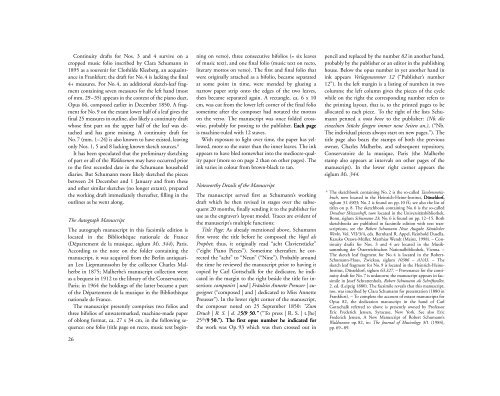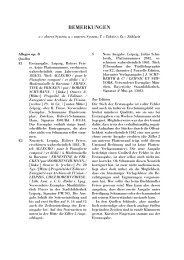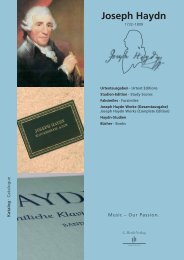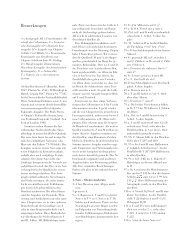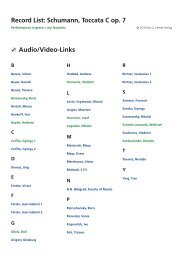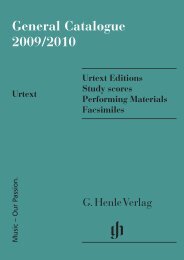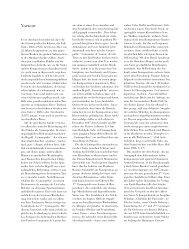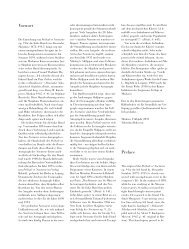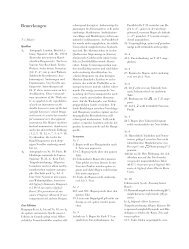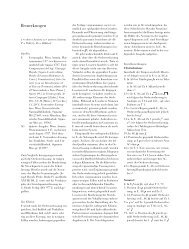Nachwort
Nachwort
Nachwort
Erfolgreiche ePaper selbst erstellen
Machen Sie aus Ihren PDF Publikationen ein blätterbares Flipbook mit unserer einzigartigen Google optimierten e-Paper Software.
Continuity drafts for Nos. 3 and 4 survive on a<br />
cropped music folio inscribed by Clara Schumann in<br />
1895 as a souvenir for Clothilde Kleeberg, an acquaintance<br />
in Frankfurt; the draft for No. 4 is lacking the final<br />
4+ measures. For No.4, an additional sketch-leaf fragment<br />
containing seven measures for the left hand (most<br />
of mm. 29–35) appears in the context of the piano duet,<br />
Opus 66, composed earlier in December 1850. A fragment<br />
for No. 9 on the extant lower half of a leaf gives the<br />
final 25 measures in outline, also likely a continuity draft<br />
whose first part on the upper half of the leaf was detached<br />
and has gone missing. A continuity draft for<br />
No. 7 (mm. 1–24) is also known to have existed, leaving<br />
only Nos. 1, 5 and 8 lacking known sketch sources. 6<br />
It has been speculated that the preliminary sketching<br />
of part or all of the Waldszenen may have occurred prior<br />
to the first recorded date in the Schumann household<br />
diaries. But Schumann more likely sketched the pieces<br />
between 24 December and 1 January and from these<br />
and other similar sketches (no longer extant), prepared<br />
the working draft immediately thereafter, filling in the<br />
outlines as he went along.<br />
The Autograph Manuscript<br />
The autograph manuscript in this facsimile edition is<br />
located in the Bibliothèque nationale de France<br />
(Département de la musique, siglum Ms. 344), Paris.<br />
According to the note on the folder containing the<br />
manuscript, it was acquired from the Berlin antiquarian<br />
Leo Liepmannssohn by the collector Charles Malherbe<br />
in 1875; Malherbe’s manuscript collection went<br />
as a bequest in 1912 to the library of the Conservatoire,<br />
Paris; in 1964 the holdings of the latter became a part<br />
of the Département de la musique in the Bibliothèque<br />
nationale de France.<br />
The manuscript presently comprises two folios and<br />
three bifolios of unwatermarked, machine-made paper<br />
of oblong format, ca. 27 x 34 cm, in the following sequence:<br />
one folio (title page on recto, music text begin-<br />
26<br />
ning on verso), three consecutive bifolios (= six leaves<br />
of music text), and one final folio (music text on recto,<br />
literary mottos on verso). The first and final folio that<br />
were originally attached as a bifolio, became separated<br />
at some point in time, were mended by glueing a<br />
narrow paper strip onto the edges of the two leaves,<br />
then became separated again. A rectangle, ca. 6 x 10<br />
cm, was cut from the lower left corner of the final folio<br />
sometime after the composer had notated the mottos<br />
on the verso. The manuscript was once folded cross-<br />
wise, probably for posting to the publisher. Each page<br />
is machine-ruled with 12 staves.<br />
With exposure to light over time, the paper has yellowed,<br />
more so the outer than the inner leaves. The ink<br />
appears to have bled somewhat into the mediocre-quality<br />
paper (more so on page 2 than on other pages). The<br />
ink varies in colour from brown-black to tan.<br />
Noteworthy Details of the Manuscript<br />
The manuscript served first as Schumann’s working<br />
draft which he then revised in stages over the subsequent<br />
20 months, finally sending it to the publisher for<br />
use as the engraver’s layout model. Traces are evident of<br />
the manuscript’s multiple functions:<br />
Title Page: As already mentioned above, Schumann<br />
first wrote the title before he composed the Vogel als<br />
Prophet; thus, it originally read “acht Clavierstücke”<br />
(“eight Piano Pieces”). Sometime thereafter, he corrected<br />
the “acht” to “Neun” (“Nine”). Probably around<br />
the time he reviewed the manuscript prior to having it<br />
copied by Carl Gottschalk for the dedicatee, he indicated<br />
in the margin to the right beside the title for insertion:<br />
componirt | und | Fräulein Annette Preusser | zugeeignet<br />
(“composed | and | dedicated to Miss Annette<br />
Preusser”). In the lower right corner of the manuscript,<br />
the composer noted on 25 September 1850: “Zum<br />
Druck | R. S. | d. 25/9 5/9 50.” (“To press | R. S. | t.[he]<br />
25th /950.”). 9 50.”). The first opus number he indicated for<br />
the work was Op. 93 which was then crossed out in<br />
pencil and replaced by the number 82 in another hand,<br />
probably by the publisher or an editor in the publishing<br />
house. Below the opus number in yet another hand in<br />
ink appears Verlagsnummer 12 (“Publisher’s number<br />
12”). In the left margin is a listing of numbers in two<br />
columns; the left column gives the pieces of the cycle<br />
while on the right the corresponding number refers to<br />
the printing layout, that is, to the printed pages to be<br />
allocated to each piece. To the right of the lists Schumann<br />
penned a nota bene to the publisher: (Nb. die<br />
einzelnen Stücke fangen immer neue Seiten an.), (“Nb.<br />
The individual pieces always start on new pages.”). The<br />
title page also bears the stamps of both the previous<br />
owner, Charles Malherbe, and subsequent repository,<br />
Conservatoire de la musique, Paris (the Malherbe<br />
stamp also appears at intervals on other pages of the<br />
manuscript). In the lower right corner appears the<br />
siglum Ms. 344.<br />
6 The sketchbook containing No. 2 is the so-called Taschennotizbuch,<br />
now located in the Heinrich-Heine-Institut, Düsseldorf,<br />
siglum 51.4903; No. 2 is found on pp.10 ff.; see also the list of<br />
titles on p. 8. The sketchbook containing No.6 is the so-called<br />
Dresdner Skizzenheft, now located in the Universitätsbibliothek,<br />
Bonn, siglum Schumann 23; No. 6 is found on pp. 12–15. Both<br />
sketchbooks are published in facsimile edition with text transcriptions,<br />
see the Robert Schumann Neue Ausgabe Sämtlicher<br />
Werke, Vol. VII/3/4, eds. Bernhard R. Appel, Reinhold Dusella,<br />
Kazuko Ozawa-Müller, Matthias Wendt (Mainz, 1998). – Continuity<br />
drafts for Nos. 3 and 4 are located in the Musiksammlung<br />
der Österreichischen Nationalbibliothek, Vienna. –<br />
The sketch leaf fragment for No. 4 is located in the Robert-<br />
Schumann-Haus, Zwickau, siglum 10306 – A1/A3. – The<br />
sketch leaf fragment for No. 9 is located in the Heinrich-Heine-<br />
Institut, Düsseldorf, siglum 63.327. – Provenance for the continuity<br />
draft for No. 7 is unknown; the manuscript appears in facsimile<br />
in Josef Schrattenholz, Robert Schumann als Schriftsteller,<br />
2. ed. (Leipzig 1880). The facsimile reveals that this manuscript,<br />
too, was inscribed by Clara Schumann for presentation (1880 in<br />
Frankfurt). – To complete the account of extant manuscripts for<br />
Opus 82, the dedication manuscript in the hand of Carl<br />
Gottschalk referred to above is presently owned by Professor<br />
Eric Frederick Jensen, Syracuse, New York. See also Eric<br />
Frederick Jensen, A New Manuscript of Robert Schumann’s<br />
Waldszenen op. 82, in: The Journal of Musicology 3/1 (1984),<br />
pp.69–89.


